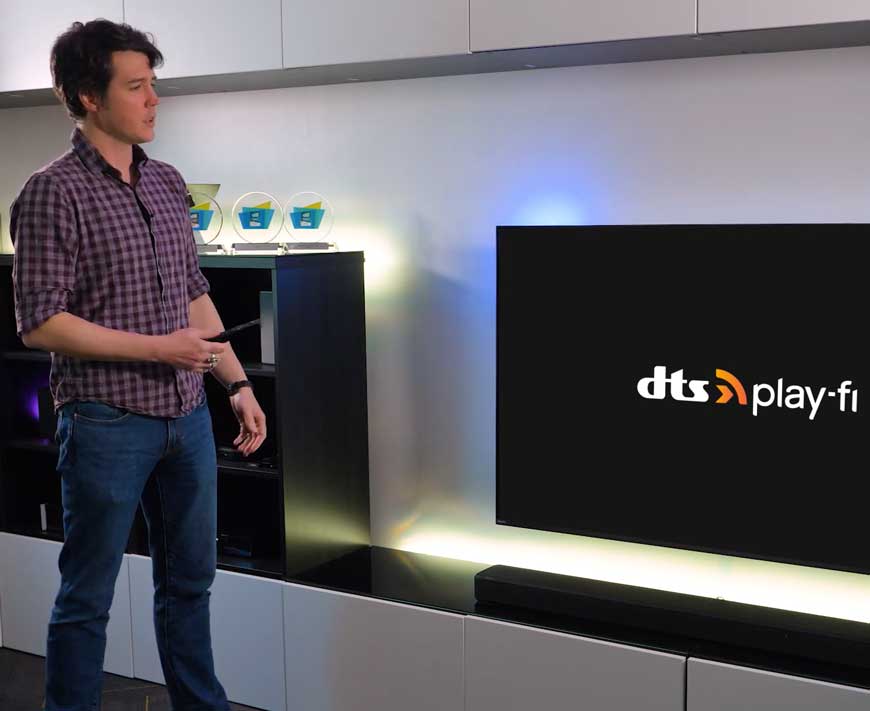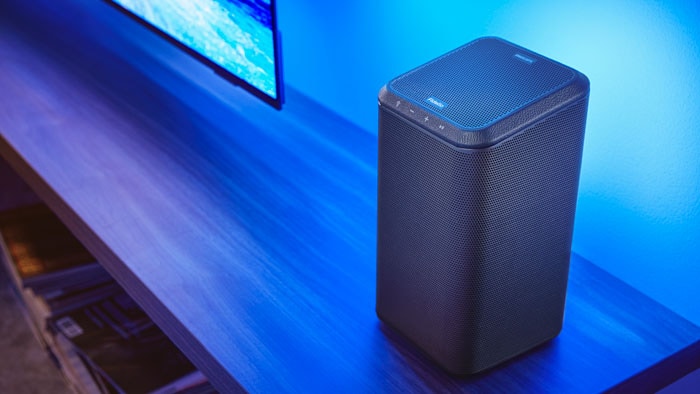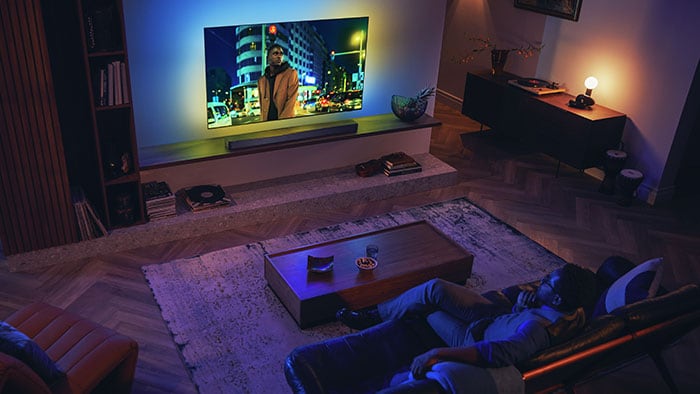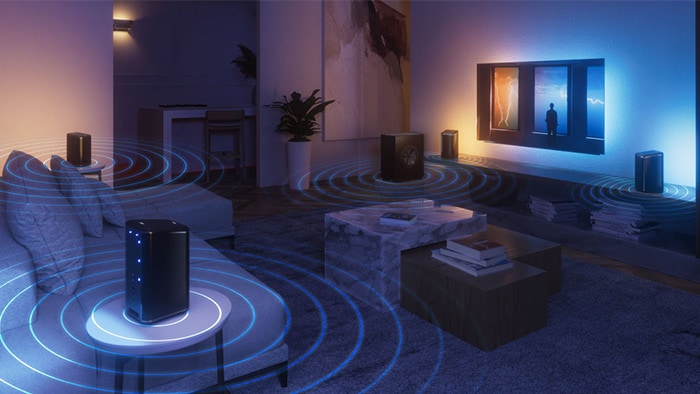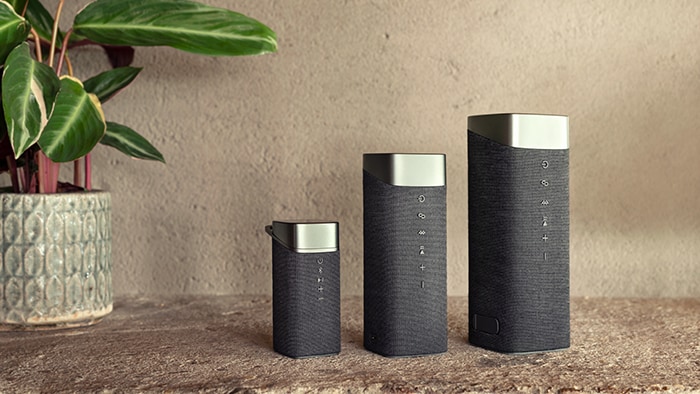How to build your home cinema
Want that epic, blockbuster experience, from the comfort of your couch? We’ll take you through our step-by-step guide to building out your home cinema. And, if you have an Ambilight TV, explain how to set it all up.
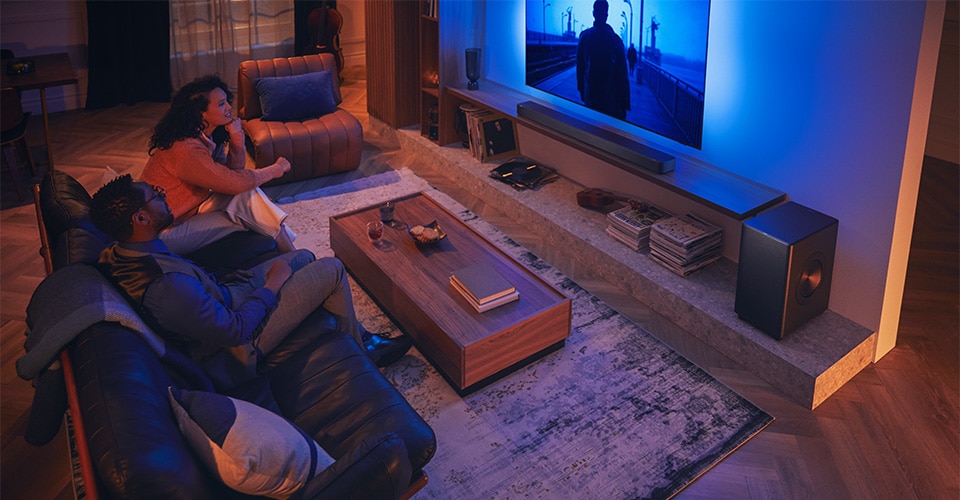
What is home cinema?
Home cinema is about trying to recreate that feeling of sitting in a movie theatre at home.
There’s no one right way to do build your home cinema. No right order. No right equipment. It’s something you can do your way and at your own pace—typically with two things in mind: great picture, and great sound.
Some assumptions
For this guide, we’re going to make a couple assumptions:
For that reason, we won’t talk about ideal room sizes, ceiling heights, or how to add an extra dry wall for optimal sound insulation. Instead, we’ll focus on making the most of what you’ve got and building from there.
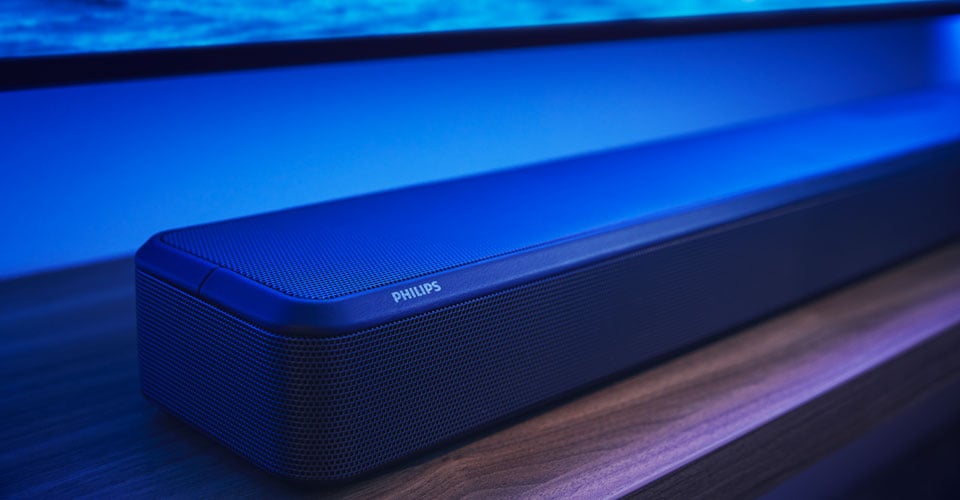
How to choose a soundbar
Once you’ve worked out if a soundbar is for you, here are five questions to answer for yourself to help narrow the search.
If there’s not much space between your TV and the cabinet, you might be looking for something ultra-compact, like the B6407. Similarly, think about the size of your room. Sure, you want to fill it. But the walls don’t have to shake.
Is the primary purpose of your soundbar to make it easier to follow dialogue? In that case, consider a 3.1 soundbar like the the one Soundbar which features a channel dedicated to dialogue.
This isn’t often a problem. Most soundbars feature multiple ways to connect. But if you have a TV with HDMI ARC or eARC, you might want a soundbar that can make the most out of its possibilities for higher quality surround sound.
If you’re thinking of expanding your home cinema setup explore how easy it is to add extra speakers. All Philips sound products are designed to work with each other and your Ambilight TV. We call this Ambilight TV surround.
There are plenty of options out there. From the more affordable to the more premium. Defining a budget from the start can save you from getting lost in the scroll.
Answering these questions can help focus your search and point you to the features most relevant to you.
1. Start with a TV
Already got one? Skip ahead. If you’re still deciding, here are a couple things that could help you make things extra cinematic.
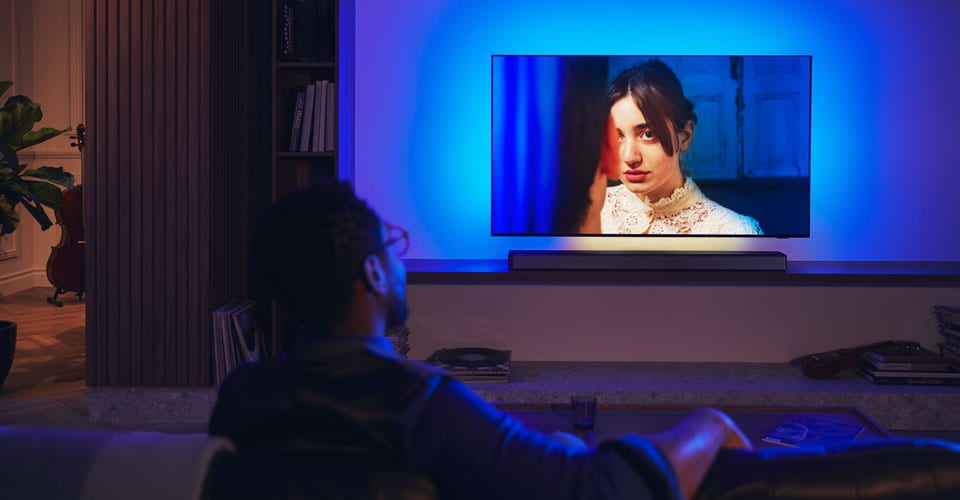
4K resolution
With four times the number of pixels as a standard HD screen, 4K TVs give you sharper, more detailed picture with more vivid colours.
HDR
High Dynamic Range is an imaging technology that produces a wider range of colours, brighter whites, and deeper blacks—for more detail in the brightest and darkest parts of the scene.
When setting up your TV, try to place it directly in front of you, at maximum angle of 15 degrees above or below you. To reduce glare, avoid placing your TV in direct sunlight.
If you have an Ambilight TV, we’d recommend positioning it between 15-20cm from your wall for the widest and most vibrant glow.
2. Choose: Soundbar or Wi-Fi Speakers?
TV, sorted. The next step is normally to choose whether you want to put a soundbar below it, or a pair of speakers to the left and right.
The only exception to this is if you have an Ambilight TV, like the OLED+ or The Xtra, with sound by Bowers & Wilkins. These already feature a dedicated sound enclosure. So, if you have one of those, skip to step 3.
When to choose a soundbar
For most people, a soundbar is the simple, satisfying choice. It beefs up your TV sound with extra detail and drama and ensures dialogue comes across clearly.
For the most detailed, cinematic effect, look out for soundbars with upward-firing speakers and Dolby Atmos, like the Fidelio FB1 or B8907.
These place objects precisely in the space around and above you. So, flocking birds and whirring choppers will sound like they’re hovering overhead.
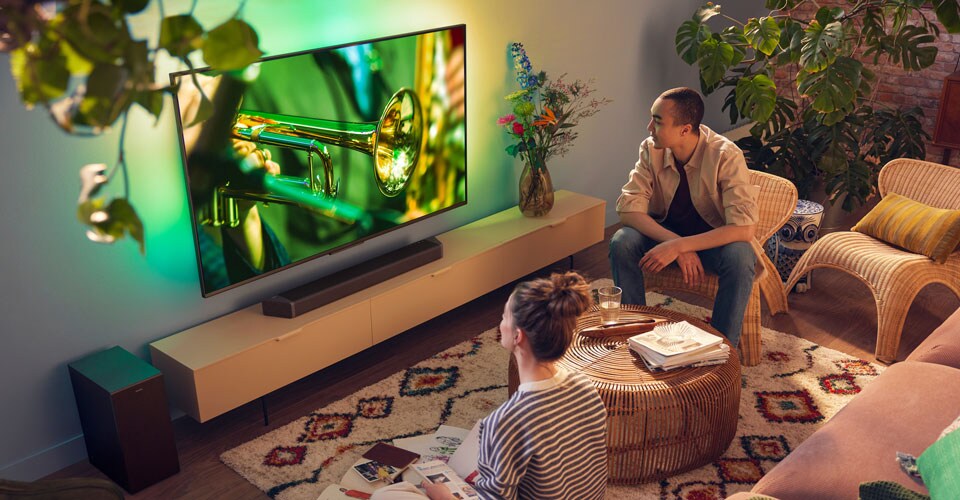
Some soundbars also come with a standalone subwoofer. We’ll explain why that’s handy, below.
Want tips on where to start your soundbar search? Check out our article on how to choose the soundbar for you.
When to choose speakers
The other option, for those who want the widest soundstage and best sound separation, is to start with a pair of wireless speakers.
Place these on either side of your TV and you’ll enjoy a wider wrap of sound, and a clearer distinction of which details are coming from where.
As well as movie watching, this setup is best for those who want to listen to music and identify the different instruments in the mix, as they would at a concert.
Like with soundbars, look out for Wi-Fi speakers with height channels, like the Fidelio FS1, to enjoy Dolby Atmos.
And, if you have an Ambilight TV, consider a pair with built in LEDs, like the W6205 or Fidelio FS1, which sync to the action and extend the lightshow through the room.
TV as centre channel
A bonus of this setup, if your TV supports it, is that it allows your TV’s speakers to be used as a centre channel.
This means your TV takes on all dialogue duties. So, as well as wider, more spacious sound from your Wi-Fi speakers, you’ll enjoy dialogue that cuts through crisp and clear.
3. Add a subwoofer
With the front speakers out of the way, you might want to give lower frequencies a bit of love. For that, you’ll need a subwoofer.
Subwoofers are what give you that rich, rumbly bass, typically tackling the frequencies between 20-200Hz. Normally they go on the floor, to the left or right of your TV.
When we think of subwoofers, we tend to imagine rocket thrusters and bursting explosions. And it’s true, a subwoofer can make scenes like those momentous.
But they’re also great for building atmosphere in quieter moments. And, by letting a subwoofer tackle the lowest frequencies, you make life easier for your other speakers, allowing them to perform more effectively.
Sometimes, a standalone subwoofer might come with your soundbar—as it does with the the one Soundbar. If that’s the case, there’s no need to buy a separate subwoofer, unless you want to double up.
4. Add rear speakers
The last step? Adding true surround sound with a pair of rear speakers.
These are Wi-Fi speakers that go behind your couch, at roughly the same height as your soundbar or front Wi-Fi speakers.
As well as giving you that full wrap of sound, rear speakers are great for creating atmosphere because they amplify the ambient sounds in the mix, without interfering with the dialogue.
In a forest scene, for example, those ambient sounds might be the croaking frogs or chirping crickets, or the murmur of a distant stream.
Directional audio also changes the game for gamers, giving you a better idea of where to seek cover when you hear enemy footsteps approaching.
As with the front Wi-Fi speakers, when choosing rear speakers, look out for those with upward-firing speakers, like the Fidelio FS1, to enjoy those added height channels.
It’s worth mentioning that Philips Wi-Fi speakers like the Fidelio FS1, and W6205 can be used as both front and rear speakers.
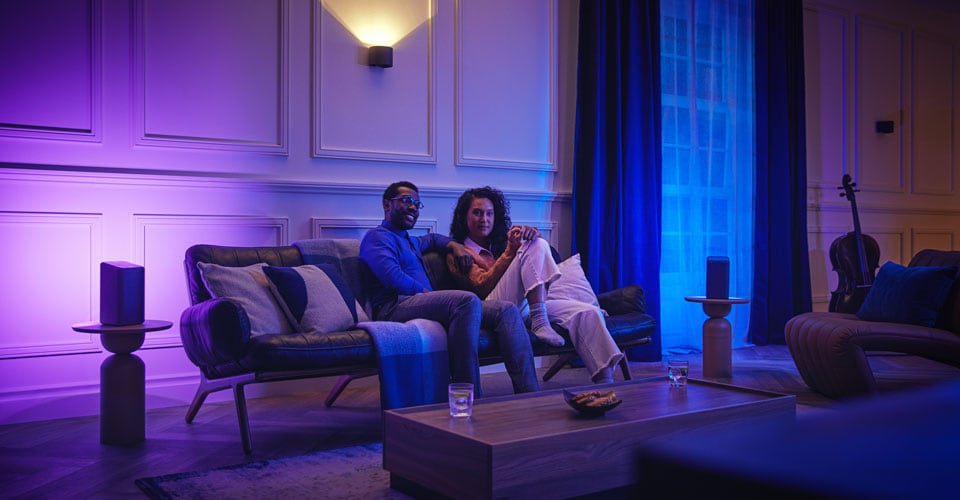
Getting your room ready
We promised at the start of this article we wouldn’t tell you to build a soundproof chamber in your living room. But there are a couple ways to help block out light and sound from outside.
The easiest, is with a thick pair of curtains. Soft furnishings, like carpets or rugs, as well as furniture like bookshelves, can also prevent unwanted echo and stop sound leaking into other parts of your house.
After that, all that’s left to do is get comfy and decide on what to watch.
What is Ambilight TV Surround?
When creating your home cinema, you might not want to do everything at once. So, it’s good to know whatever you buy will work together without any fuss.
That’s why all Philips soundbars, speakers, and subwoofers are designed to work seamlessly with each other and get the most out of your Ambilight TV. We call this Ambilight TV Surround.
Powered by DTS Play-Fi, it lets you stream your sounds in high quality, up to 24-bit/192kHz, over Wi-Fi.
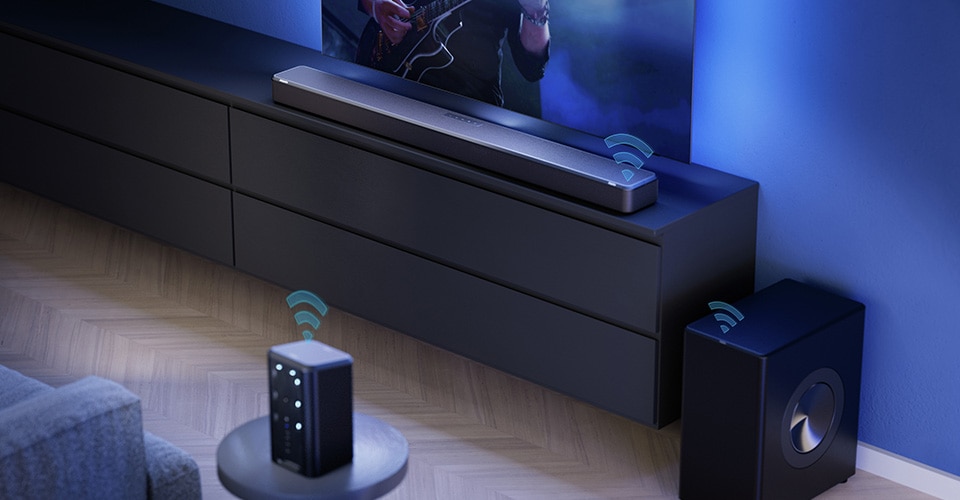
How to setup Ambilight TV Surround home cinema?
That’s it. You can now enjoy cinematic sound from your Ambilight TV.
Watch the video
-
Fidelio
Wireless speaker
TAFS1/37
- Philips Wireless Home System
- 120W max
- Works with Ambilight TVs
- Sustainable Muirhead leather
-
- Dolby Atmos. IMAX Enhanced
- Philips Wireless Home System
- 620 W max. Built-in subwoofer
- Easy room calibration
-
Fidelio
Wireless subwoofer
TAFW1/37
- 420 W max. 8" woofer
- Dual wOOx passive radiators
- Philips Wireless Home System
- Sustainable Muirhead leather
